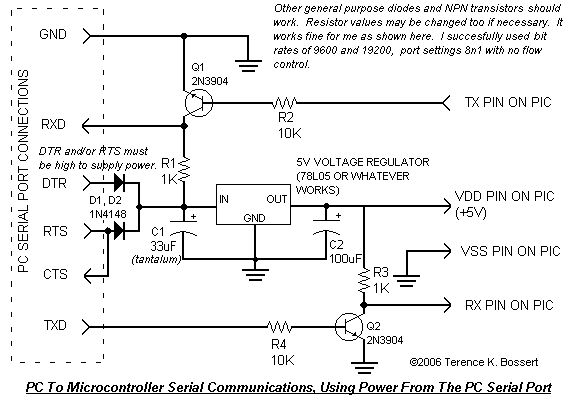Difference between revisions of "RS232 Dev Board"
(Replacing page with 'Dis website is Great! I will recommend you to all my friends. Thank you. [http://minimality6.conforums.com/ ethnic shemales] | [http://escalatorsu24.www2.prexon.nl/ cute she...') |
m (Reverted edits by 202.85.54.90 (Talk); changed back to last version by DavidCary) |
||
| (70 intermediate revisions by 46 users not shown) | |||
| Line 1: | Line 1: | ||
| − | + | A simple RS232 example project that takes all the power it needs from the serial port. Use it to power your microcontroller and communicate between serial port and microcontroller. Takes advantage of the fact that pc serial ports will accept 0-5V rather than the RS232 standard of around negative 10V to positive 10V. Very convenient - no external power required! Note that you may use either a 5.1V zener or a 5V regulator. | |
| − | + | [[Image:PicPcSerialSchematic.gif ]] | |
| − | |||
| − | + | <br><br>In the circuit above, the two 1N4148 diodes prevent any negative voltage getting into the rest of the circuit if either DTR or RTS would happen to go negative. The two transistors function as transistor switches. The transistors also act as inverters. We need to invert things since the pc serial port uses positive voltage to represent binary 0 (RS232 SPACE) and negative voltage (or lucky for us 0 voltage) for binary 1 (RS232 MARK). Of course the voltage regulator regulates the voltage with some decoupling capacitors. A zener diode can also be used to regulate the voltage. In my schematic, you can see that I developed this for my PIC projects, but other microcontrollers will probably have similar serial communications methods and similar supply voltage requirements. | |
| − | + | <br><br> | |
| − | + | One thing I needed to do to use this with my solderless breadboard was to connect the metal on the bottom of the breadboard to ground. You may need a similar sort of grounded shielding near your circuitry if you use this. | |
| − | [http:// | + | |
| − | [ | + | * NØXAS shows [http://botkin.org/dale/rs232_interface.htm how to replace the BJTs in this circuit with FETs], which is simpler and (now that FETs have plummeted in price) cheaper. |
| − | + | ||
| + | [[Category:Projects]] | ||
Latest revision as of 04:15, 16 July 2008
A simple RS232 example project that takes all the power it needs from the serial port. Use it to power your microcontroller and communicate between serial port and microcontroller. Takes advantage of the fact that pc serial ports will accept 0-5V rather than the RS232 standard of around negative 10V to positive 10V. Very convenient - no external power required! Note that you may use either a 5.1V zener or a 5V regulator.

In the circuit above, the two 1N4148 diodes prevent any negative voltage getting into the rest of the circuit if either DTR or RTS would happen to go negative. The two transistors function as transistor switches. The transistors also act as inverters. We need to invert things since the pc serial port uses positive voltage to represent binary 0 (RS232 SPACE) and negative voltage (or lucky for us 0 voltage) for binary 1 (RS232 MARK). Of course the voltage regulator regulates the voltage with some decoupling capacitors. A zener diode can also be used to regulate the voltage. In my schematic, you can see that I developed this for my PIC projects, but other microcontrollers will probably have similar serial communications methods and similar supply voltage requirements.
One thing I needed to do to use this with my solderless breadboard was to connect the metal on the bottom of the breadboard to ground. You may need a similar sort of grounded shielding near your circuitry if you use this.
- NØXAS shows how to replace the BJTs in this circuit with FETs, which is simpler and (now that FETs have plummeted in price) cheaper.